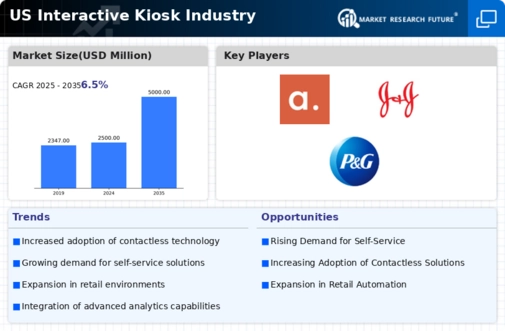Rising Focus on Data Analytics
The interactive kiosk market is increasingly influenced by the rising focus on data analytics. Businesses are utilizing kiosks not only for customer interaction but also for gathering valuable data on consumer behavior and preferences. This data-driven approach allows companies to tailor their offerings and improve service delivery. The integration of analytics into kiosk operations is expected to enhance decision-making processes, leading to more personalized customer experiences. As organizations recognize the value of data insights, the interactive kiosk market is likely to see a boost in adoption rates, particularly among retailers and service providers aiming to optimize their operations.
Emphasis on Enhanced Customer Engagement
The interactive kiosk market is characterized by an emphasis on enhanced customer engagement strategies. Businesses are increasingly recognizing the importance of interactive experiences in driving customer loyalty and satisfaction. Kiosks are being designed to facilitate two-way communication, allowing customers to provide feedback and engage with brands in real-time. This shift towards interactive engagement is supported by research indicating that engaged customers are more likely to make repeat purchases. As companies strive to create memorable customer experiences, the interactive kiosk market is likely to expand, with a focus on innovative designs and interactive features.
Expansion of Digital Signage Applications
The interactive kiosk market is witnessing a significant expansion in digital signage applications, which are becoming integral to marketing strategies. Businesses are leveraging kiosks to deliver dynamic content, promotions, and advertisements directly to consumers. This shift is supported by the increasing effectiveness of digital signage in capturing consumer attention, with studies indicating that digital displays can increase sales by up to 30%. As companies seek innovative ways to engage customers, the interactive kiosk market is poised for growth, particularly in sectors such as hospitality and entertainment, where visual communication plays a crucial role in enhancing the customer experience.
Growing Demand for Self-Service Solutions
The interactive kiosk market is experiencing a notable surge in demand for self-service solutions across various sectors. This trend is particularly evident in retail, where businesses are increasingly adopting kiosks to enhance customer experience and streamline operations. According to recent data, the self-service kiosk segment is projected to grow at a CAGR of approximately 10% through 2027. This growth is driven by the need for efficient service delivery, reduced wait times, and improved customer satisfaction. As consumers become more accustomed to self-service options, the interactive kiosk market is expected to expand further, as businesses recognize the potential for increased sales and operational efficiency.
Increased Investment in Smart Technologies
The interactive kiosk market is benefiting from increased investment in smart technologies, which are enhancing the functionality and appeal of kiosks. Innovations such as touchless interfaces, facial recognition, and mobile integration are becoming more prevalent, allowing for a seamless user experience. This trend is particularly relevant in sectors like healthcare and transportation, where efficiency and safety are paramount. As businesses seek to modernize their service offerings, the interactive kiosk market is expected to grow, with smart technologies playing a pivotal role in attracting and retaining customers.













Leave a Comment